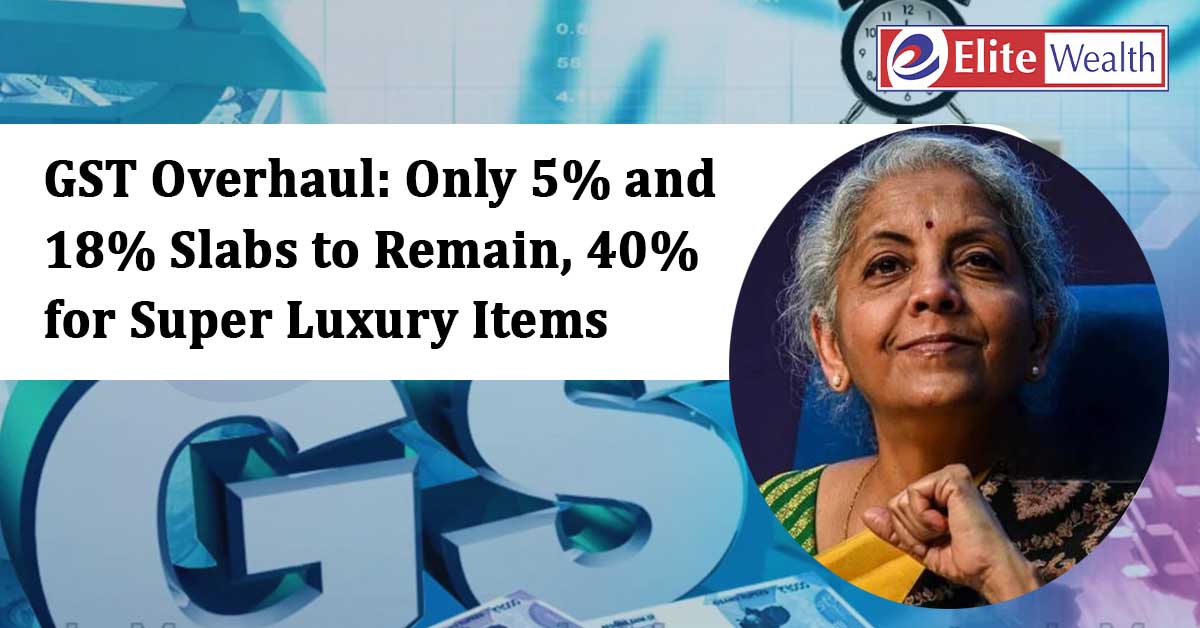
GST Overhaul: Only 5% and 18% Slabs to Remain, 40% for Super Luxury Items
From September 22, India will move towards a simpler Goods and Services Tax (GST) structure, with only two primary slabs – 5% and 18%. The higher rate of 40% will continue to apply to super luxury goods and sin items.
The decision was taken by the GST Council, which reviewed the existing system and concluded that the complex slab structure was no longer efficient. According to Finance Minister Nirmala Sitharaman, these reforms are aimed at “improving ease of living for citizens and ease of doing business” while ensuring revenue stability. The government estimates a revenue implication of nearly ₹48,000 crore, with hopes that higher consumer savings will flow back into the economy.
Key Tax Changes: What Gets Cheaper, What Doesn’t
- Essentials and Healthcare:
The biggest relief comes for consumers of food, medicines, farm goods, and green energy products.- Life and health insurance policies, including family floater plans, will no longer attract GST.
- 33 life-saving drugs, including cancer medicines, earlier taxed at 12%, are now fully exempt.
- Widely used medical devices such as thermometers and glucometers have been shifted to the 5% slab.
- Consumer Durables and Vehicles:
Goods like televisions, air conditioners, and motorcycles under 350cc will fall under the 18% tax rate, down from 28%.
Similarly, small cars (petrol up to 1200cc and diesel up to 1500cc) are now taxed at 18%, making them relatively more affordable. Larger cars, SUVs, and high-end bikes remain in the 28%+ category. - Luxury & Sin Goods:
Items such as tobacco products, carbonated drinks, mid-to-large cars, and motorcycles above 350cc will attract a steep 40% tax.
Why the System Was Simplified
Until now, GST had four slabs – 5%, 12%, 18%, and 28%. But data revealed that:
- The 18% category alone contributed around 67% of total GST collections over the past eight years.
- The 12% slab added barely 5%, making it negligible.
- The 28% slab accounted for 11%, while the 5% slab generated about 7%.
Since the 5% and 18% brackets together contributed nearly three-fourths of GST revenue, the council decided to remove the 12% and 28% categories for simplicity and efficiency.
GST – A Look Back
Introduced on July 1, 2017, GST replaced multiple indirect taxes under the promise of “one nation, one tax, one market.” Launched at Parliament’s Central Hall by Prime Minister Narendra Modi and then President Pranab Mukherjee, it was considered India’s biggest tax reform since independence.
While the new system streamlined taxation, traders and small businesses faced early challenges, especially with online return filings. Over time, many of these issues were resolved, though occasional glitches, filing delays, and confusion over slab applicability persisted.
Summary
With the latest revamp, GST moves closer to becoming a simpler and more transparent tax regime. The elimination of mid-range slabs and the reduction of rates on essential goods aim to ease consumer burden while still safeguarding revenue. For everyday households, this translates into lower costs on essentials and healthcare, while high-end luxury and sin goods continue to bear a heavier tax load.
Disclaimer:
This article is intended solely for educational and informational purposes. The securities or companies mentioned are provided as examples and should not be considered as recommendations. Nothing contained herein constitutes personal financial advice or investment recommendations. Readers are advised to conduct their own research and consult a qualified financial advisor before making any investment decisions.
Investments in securities markets are subject to market risks. Please read all related documents carefully before investing.
